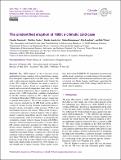Files in this item
The unidentified eruption of 1809 : A climatic cold case
Item metadata
| dc.contributor.author | Timmreck, Claudia | |
| dc.contributor.author | Toohey, Matthew | |
| dc.contributor.author | Zanchettin, Davide | |
| dc.contributor.author | Brönnimann, Stefan | |
| dc.contributor.author | Lundstad, Elin | |
| dc.contributor.author | Wilson, Rob | |
| dc.date.accessioned | 2021-08-19T16:30:09Z | |
| dc.date.available | 2021-08-19T16:30:09Z | |
| dc.date.issued | 2021-07-13 | |
| dc.identifier | 275502104 | |
| dc.identifier | 5377d716-66af-4394-a90e-501097e8ff46 | |
| dc.identifier | 85110286550 | |
| dc.identifier | 000672856600001 | |
| dc.identifier.citation | Timmreck , C , Toohey , M , Zanchettin , D , Brönnimann , S , Lundstad , E & Wilson , R 2021 , ' The unidentified eruption of 1809 : A climatic cold case ' , Climate of the Past , vol. 17 , no. 4 , pp. 1455-1482 . https://doi.org/10.5194/cp-17-1455-2021 | en |
| dc.identifier.issn | 1814-9324 | |
| dc.identifier.other | ORCID: /0000-0003-4486-8904/work/151190613 | |
| dc.identifier.uri | https://hdl.handle.net/10023/23800 | |
| dc.description | This research has been supported by the Deutsche Forschungsgemeinschaft Research Unit VolImpact (FOR2820, grant no. 398006378) within the project VolClim, the European Commission, the European Research Council (PALAEO-RA (grant no. 787574)), and the Schweizerischer Nationalfonds zur Förderung der Wissenschaftlichen Forschung (WeaR; grant no. 188701). | en |
| dc.description.abstract | The "1809 eruption"is one of the most recent unidentified volcanic eruptions with a global climate impact. Even though the eruption ranks as the third largest since 1500 with a sulfur emission strength estimated to be 2 times that of the 1991 eruption of Pinatubo, not much is known of it from historic sources. Based on a compilation of instrumental and reconstructed temperature time series, we show here that tropical temperatures show a significant drop in response to the ~1809 eruption that is similar to that produced by the Mt. Tambora eruption in 1815, while the response of Northern Hemisphere (NH) boreal summer temperature is spatially heterogeneous. We test the sensitivity of the climate response simulated by the MPI Earth system model to a range of volcanic forcing estimates constructed using estimated volcanic stratospheric sulfur injections (VSSIs) and uncertainties from ice-core records. Three of the forcing reconstructions represent a tropical eruption with an approximately symmetric hemispheric aerosol spread but different forcing magnitudes, while a fourth reflects a hemispherically asymmetric scenario without volcanic forcing in the NH extratropics. Observed and reconstructed post-volcanic surface NH summer temperature anomalies lie within the range of all the scenario simulations. Therefore, assuming the model climate sensitivity is correct, the VSSI estimate is accurate within the uncertainty bounds. Comparison of observed and simulated tropical temperature anomalies suggests that the most likely VSSI for the 1809 eruption would be somewhere between 12 and 19ĝ€¯Tg of sulfur. Model results show that NH large-scale climate modes are sensitive to both volcanic forcing strength and its spatial structure. While spatial correlations between the N-TREND NH temperature reconstruction and the model simulations are weak in terms of the ensemble-mean model results, individual model simulations show good correlation over North America and Europe, suggesting the spatial heterogeneity of the 1810 cooling could be due to internal climate variability. | |
| dc.format.extent | 28 | |
| dc.format.extent | 5163731 | |
| dc.language.iso | eng | |
| dc.relation.ispartof | Climate of the Past | en |
| dc.subject | GE Environmental Sciences | en |
| dc.subject | Global and Planetary Change | en |
| dc.subject | Stratigraphy | en |
| dc.subject | Palaeontology | en |
| dc.subject | DAS | en |
| dc.subject | SDG 13 - Climate Action | en |
| dc.subject.lcc | GE | en |
| dc.title | The unidentified eruption of 1809 : A climatic cold case | en |
| dc.type | Journal article | en |
| dc.contributor.institution | University of St Andrews. School of Earth & Environmental Sciences | en |
| dc.contributor.institution | University of St Andrews. Scottish Oceans Institute | en |
| dc.contributor.institution | University of St Andrews. St Andrews Sustainability Institute | en |
| dc.identifier.doi | https://doi.org/10.5194/cp-17-1455-2021 | |
| dc.description.status | Peer reviewed | en |
This item appears in the following Collection(s)
Items in the St Andrews Research Repository are protected by copyright, with all rights reserved, unless otherwise indicated.

